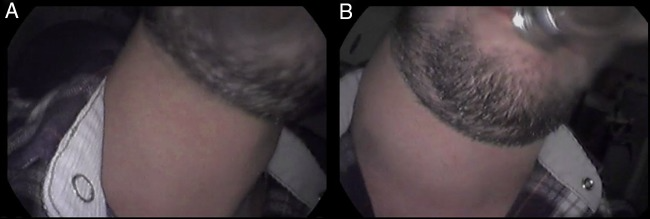Pharyngocele: a rare condition in musicians
This article describes the case of a 20-year-old trumpet player who presented with a 5-year-history of neck swelling. Doctors were suspicious of a pharyngocele. However, imaging led to some confusion with the diagnosis. Bilateral neck swelling in patients post valsalva manoeuvres can lead to the diagnosis of a pharyhgocele or laryngocele. But differentiating between the two can be complicated, given the presence of an acute airway in patients with laryngoceles.
Both the conditions can be a result of prolonged positive pressure. Therefore, to confirm the diagnosis, it is essential to assess with fibreoptic examination and imaging. Pharyngoceles are often confused with laryngoceles. Although treatment is similar for both, it is important to make the distinction for careful observation of the airway in patients with laryngoceles. This case highlights bilateral neck swelling, with suspicion of laryngoceles and pharyngoceles.
Case presentation: pharyngocele
The 20-year-old male trumpet player was referred to the tertiary ear, nose and throat clinic with bilateral neck swelling with a history of 5 years. According to the patient, the swelling would appear while playing the trumpet and resolve between episodes. He had no other symptoms of difficulty breathing, dysphagia or dysphonia associated with the swelling. He was otherwise fit and had no significant medical history.
The patient was earlier referred for imaging which showed no cause for the swelling. Doctors further recalled him to the clinic with the trumpet to reproduce the symptoms. The patient’s head and neck examination at rest showed no abnormal findings, visible or palpable neck lumps or swellings. However, on blowing the trumpet there was significant bilateral external neck swelling.
In this case, blowing the trumpet produced significant bilateral external neck swelling. Similarly, doctors advised a videostobolaryngoscopy during the trumpet blowing which confirmed the diagnosis of a pharyngocele. Whereas the remaining supraglottic structures did not show any significant findings. The movement of the vocal cords was normal, both bilaterally. The patient was further referred for a CT scan while playing the trumpet to estimate the size of the defect. In addition, to allow for surveillance and future comparison.
Initially, doctors reported the enlarged piriform fossa as a ‘large bilateral gas-filled laryngoceles’. Although, after further review, the patient was given the diagnosis of a pharyngocele.
Subsequently, the patient was also referred for a barium swallow to look for pockets or pouches of the hypopharynx. This is because, without positive pressure, it is impossible to blow and swallow at the same time. Since there were no evident symptoms, the patient was treated with a conservative approach and was advised regarding healthy oral hygiene. He was also advised to tie a scarf while playing.
Background
Neck swelling in association with positive pressure, for example, glass blowing or playing a musical instrument is generally because of a pharyngocele or laryngocele. Although both are quite rare. And differentiating between the two may be difficult. Similarly, pharyngoceles are often underdiagnosed or misdiagnosed as laryngoceles. While the differences are often subtle, doctors can directly diagnose them with the targeted investigation.
Diagnosis
A laryngocele is defined as an ‘abnormal dilation or herniation of the laryngeal saccule’. “According to Holinger can be diagnosed if the sac is (1) symptomatic, (2) palpable, (3) observed internally or (4) observed through imaging or surgery”. Laryngoceles are either congenital or acquired, although the majority of the lesions are acquired. The lesions are a result of intralaryngeal pressure, for example, excessive coughing, playing blowing instruments or obstructing lesions within the larynx.
Pharyngoceles are described based on their relation to the parapharyngeal space. It is described as internal if it is confined to the parapharyngeal space. Whereas external, if there is saccule herniation through the thyrohyoid membrane, or mixed and can be both unilateral and bilateral.
Laryngoceles are usually asymptomatic and are often detected incidentally. However, in some cases, they may present with symptoms such as simple neck swelling, hoarseness of voice to airway obstruction. Options for management include wearing a scarf during times of high pressure and surgical excision of the saccule. Whereas novel treatment options include transoral robotic surgery and endoscopic repair which also eliminate the need of cervical incisions. The study further states, “In contrast, a pharyngocele is a bulging of the lateral pharyngeal wall frequently arising from two areas of weakness; a superior area between the middle and superior constrictor muscle and the most common site; inferiorly between the middle and inferior constrictor muscle and the thyrohyoid membrane within the base of the piriform fossa”.
Management
Pharyngoceles and laryngoceles are both rare conditions that can present in musicians. Symptoms include asymptomatic neck swelling and symptoms for both can mimic each other very closely. Similarly, while imaging during valsalva can be used for diagnosis, it is important to have a high index of suspicion to diagnose correctly. Patients are often diagnosed with laryngoceles but it is important to closely assess on flexible nasendoscopy to visualise the origin of the sac. Studies state that patients who are asymptomatic can be managed conservatively, whereas surgical options should be for refractory cases and where patients are asymptomatic.
Source: NCBI




